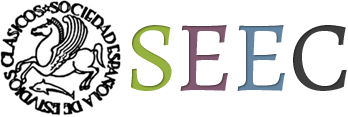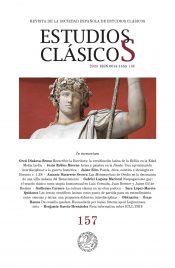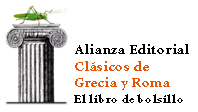Arma y palabra en la Ilíada: Una aproximación interdisciplinar a la guerra homéricaWeapon and Word in Iliad: An interdisciplinary approach to Homeric Warfare
Jesús Robles Moreno
Resumen
El presente trabajo aborda las armas y las tácticas de combate presentes en Ilíada de manera interdisciplinar, combinando Filología y Arqueología. El objetivo de este análisis es comprender la naturaleza de las panoplias presentes en el poema, ubicarlas cronológicamente, y ver cómo en el texto perviven y se emplean diferentes tipos de armas. Analizando el armamento a través de la lingüística y buscando el correlato arqueológico, se distinguen en Ilíada al menos tres momentos históricos que abarcan desde la época micénica antigua (s.XVI a.C.) hasta los inicios del Período Arcaico (s. VIII a.C.).
Palabras clave: Homero; Ilíada; armas; guerra
Abstract
This paper studies the weaponry and warfare tactics in Homer’s Iliad in an interdisciplinary way, combining Philology and Archaeology. The aim of this analysis is to understand the nature of the panoplies of this poem, establish their chronology and study how they survive and the way they are used in it. By analyzing weapons from linguistics and searching for the archaeological correlate, we can distinguish at least three different moments in Iliad, ranging from an early Mycaenean era (XVI th century b.C.) to the beginnings of Arcaism (VIII b.C.).
Keywords: Homer; Iliad; weapons; warfare
Referencias bibliográficas
ÅSTRÖM, P. (1977): The Cuirass Tomb and other finds at Dendra. Part I: The chamber tombs, Gotemburgo, Åström.
BATMAZ, A. (2013) «A lion-headed shield from Ayanis: An identifier of the Urartian culture?» , en L. Bombardieri et al. (eds.) Identity and connectivity. Proceedings of the 16th symposium on Mediterranean Archaeology, Florence, 1-3 May 2012, Oxford, BAR Publishing, 243-252.
BECK, W. (1979) «αὐλῶπις» en Snell, B. (ed.) Lexicon des frühgriechischen Epos, Vol. 1, Gotinga, Vandenhoeck & Ruprecht, 1557-1559.
BERSHADSKY, N. (2010) «The Unbreakable Shield: Thematics of Sakos and Aspis», Classical Philology 105.1, 1-24.
BIERL, A. (2015) «New trends in Homeric scholarship» en A. Bierl y J. Latacz (eds.) Homers Ilias Gesamtkommentar. Prolegomena, Berlín, De Gruytier, [reed. De Gruyter, Boston, 2015].
BOARDMAN, J. (1974) Athenian black figure vases, Londres, Thames and Hudson.
BORCHHARDT, J. (1972) Homerische Helme: Helmformen der Ägäis in ihren Beziehungen zu orientalischen und europäischen Helmen in der Bronze- und fruhen Eisenzeit. Maguncia, Philip von Zabern.
BRANDEMBURG, H. (1977) «Mitra–Zoma–Zoster», en H.G. Buchholz & J. Wiesner (1977) (eds.) Kriegswesen. Teil 1. Schutzwaffen und Wehrbauten. Archaeologia Homerica, I, Gotinga, Vandenhoeck und Ruprecht, 119-143.
BROUWERS, J. (2016) Esbirros de Ares. La guerra en la Grecia arcaica, Madrid, Desperta Ferro Ediciones.
BRÜGGER, C. (2016): Homers Ilias. Gesamtkommentar. Band IX: Sechzehnter Gesang, Faszikel 2: Kommentar, eds. A. Bierl y J. Latacz, Berlín, De Gruyter.
BUCHHOLZ, H.G. (1980) Kriegswesen. Teil 2. Angriffswaffen, Archaeologia Homerica., I.2, Gotinga, Vandenhoeck und Ruprecht.
BUCHHOLZ, H.G. & WIESNER, J. (1977) (eds.) Kriegswesen. Teil 1. Schutzwaffen und Wehrbauten, Archaeologia Homerica, I, Gotinga, Vandenhoeck und Ruprecht.
CASSOLA, P. (1973) Le armi defensive dei micenei nelle figurazioni, Roma, Ateneo.
CATLING, H.W. (1977) «Panzer», en H.G. Buchholz & J. Wiesner (1977) (eds.) Kriegswesen. Teil 1. Schutzwaffen und Wehrbauten. Archaeologia Homerica, I, Gotinga, Vandenhoeck und Ruprecht, 74-118.
CONTI, L. (1999) «Zur Bedeutung von τυγχάνω und ἁμαρτάνω bei Homer» Glotta 75, 50-62.
COURBIN, P. (1957) «Une tombe géometrique d’Argos», Bulletin de Correspondance Hellénique 81, 322-386.
CRESPO, E. (1991) Homero: Ilíada. Madrid, Gredos.
D’AMATO, R. & SALIMBETI, A. (2016) Early Iron Age Greek warrior (1100-100 BC), Osprey Warrior Series, 180, Londres, Osprey.
DAVIS, J.L. & STOCKER, S.R. (2016) «The lord of the gold rings: The Griffin Warrior of Pylos», Hesperia 85, 627-655. DOI: 10.2972/hesperia.85.4.0627
DOTHAN, T. (1982) The Philistines and their material culture, New Haven, Yale University Press.
ECHEVERRÍA, F. (2008) Ciudadanos, campesinos y soldados. El nacimiento de la «polis» griega y la teoría de la «Revolución hoplita», Anejos de Gladius 12, Madrid, Consejo Superior de Investigaciones Científicas.
EGG, G. & TOMEDI, M. (2014) «Zur Chronologie bronze- und früheisenzeitlicher Kammhelme», Archäologisches Korrespondenzblatt 44, 41-57.
GJESTARD, E.; LINDROS, J., SJÖQVIST, E. & WESTHOLM, A. (1935) The Swedish Cyprus Expedition, Vol. II, Estocolmo, Viktor Peterssons Bok Industriak.
GRECO, A. (2002) «Aiace Telamonio e Teucro. Le techniche di combattimento nella Grecia micenea dell’età delle tombe a fossa», en F. Montari, F. y Ascheri, P. (eds.) Omero tremila anni dopo. Atti del Congreso Genova 6-8 Iuglio 2000, Roma, Edizioni di storia e letteratura, 561-578.
— (2006) «La Grecia tra il Bronzo Medio e il Bronzo Tardo: L’armamento di Aiace e il duo guerriero», en D. Morandi; E. Rova; F. Veronese & P. Zanovello (eds.) Tra Oriente e Occidente. Studi in onore di Elena di Filippo Balestrazzi. Padua, Sargón, 265-289.
HAINSWORTH, B. (1993): The «Iliad»: A commentary. Vol. 3: Books 9-12, ed. G. Kirk, Cambridge, Cambridge University Press.
HILLER, S. (1999) «Scenes of warfare and the combats in the arts of Aegean Late Bronze Age: Reflections on typology and development», en R. Laffineur (ed.) Polemos. Le contexte guerrier en Égée à L’Âge du Bronze, Lieja, Aegeum, 319-330.
KARO, G. (1933): Die Schachtgräber von Mykenai, Múnich, Bruckmann.
KENDALL, T. (1981) «Gurpisu sa awelli: The helmets of the warriors at Nuzi», en M.A. Morrison & D.I. Owen (eds.) Studies in the Civilization and Culture of Nuzi. In honour of Ernest H. Lacheman, Indiana, Eisenbrauns, 201-231.
KILIAN-DIRLMEIER, I. (1980) «Remarks on the non-military functions of swords in the Mycenaean Argolid», en R. Hägg & G.C. Nordquist (eds.) Celebrations of death and divinity in the Bronze Age Argolid, Estocolmo, Åström, 157-161.
— (1993) Die schwerter in Griechenland (außerhalb der Peloponnes), Bulgarien und Albanien. Stuttgart, Prähistorische Bronzefunde.
KIRK, G. (1985) The «Iliad»: A commentary. Volume I: Books 1-4, ed. G. Kirk, Cambridge, Cambridge University Press.
— (1990) The «Iliad»: A commentary. Volume II: Books 5-8, ed. G. Kirk, Cambridge, Cambridge University Press.
KRIETER-SPIRO, M. (2009): Homers Ilias. Gesamtkommentar. Band III: Dritter Gesang, Faszikel 2: Kommentar, eds. A. Bierl y J. Latacz, Berlín, De Gruyter.
KUNZE, E. (1931) Kretische Bronzereliefs. Stuttgart, Verlag von W. Kohlhammer.
LATACZ (2000) «Formelhaftigkeit und Mündlichkeit » en A. Bierl y J. Latacz (eds.) Homers Ilias Gesamtkommentar. Prolegomena, Berlín, De Gruyter, 39-60
LEBESSI, A. (1992) «Zum Phalos des homerischen Helms», Mitteilungen des Deutschen Archäologischen Instituts, Athenische Abteilung 107, 1–10.
LORIMER, H.L. (1950) Homer and the monuments, Londres, Macmillan.
MACK, R. (2002) «Facing down Medusa (An aetology of the gaze) », Art History 25, 571-604.
MARX, P.A. (1993) «The introduction of the gorgoneion to the shield and aegis of Athena and the question of Endoios», Revue Archéologique 2, 227-268.
MENICHETTI, M. (2006) «Lo scudo di Achille. Problemi e interpretazioni», en H. Françoise & M. Pairault (eds.) L’image antique et son interprétation. Roma, École Française de Rome, 7-18.
— (2009) «Le armi magiche della guerra e della seduzione. I modelli omerici», Incidenza dell’Antico 7, 2009, 137-157.
MOSCHOS, I. (2009) «Evidence of social re-organisation and reconstruction in Late Helladic IIIC Achaea and modes of contacts and exchange via the Ionian and Adriatic Sea» en E. Borgna y P. Càssola (eds.) From the Aegean to the Adriatic, social organizations, modes of exchange and interaction in the postpalatial times (12-11 b.C.), Roma, Quasar, 345-414.
MÖDLINGER, M. (2013) «From Greek boar tusks helmets to the first European metal helmets», Oxford Journal of Archaeology 32.4, 391-412, DOI: https://doi.org/10.1111/ojoa.12021
- (2017) Protecting the body in war and combat. Metal body armour in Bronze Age Europe, Oriental and European Archaeology 6, Viena, Österreichischen Akademie der Wissenschaften.
MOLLOY, B. (2005) «Naue II and the collapse of the Aegean Bronze Age», en Briault, C., Green, J. & Kaldelis, A. Fazlullin,S. Antika, M.M. (eds.) Symposium on Mediterranean Archaeology 2003, Oxford, BAR Publishing, 115-117.
— (2008) «Martial arts and materiality: a combat archaeology perspective on Aegean swords of the fiftheenth and fourteenth centuries b.C. », World Archeology, 40, 116-134, DOI: 10.1080/00438240701843611
— (2010) «Sword and swordmanship in the Aegean Bronze Age» American Journal of Archeology 114, 403-428.
MÖRTZ, T. (2015) «Metal Heads: a review on the origin and spread of two-piece helmets in the European Bronze Age», en P. Suchowska-Duke, S. Reiter, & H. Vankilde (eds.) Forging identities. The mobility of culture in Bronze Age Europe. Vol. 2, Oxford, BAR Publishing, 107- 114.
MUSTI, D. (2008) Lo Scudo di Achille. Idee e forme di città nel mondo antico, Bari, Laterza.
MUTH, S. (2008) Gewalt im Bild. Das Phänomen der medialen Gewalt im Athen des 6. und 5. Jahrhunderts v. Chr., Berlín, De Gruyter.
NAGY, G. (1996) Homeric questions. Texas, Texas University Press.
NEER, R.T. (2012) Art and Archaeology of the Greek World, Londres, Thames & Hudson.
PERSSON, A.W. (1931) The royal tombs at Dendra Near Midea, Oxford, Oxford University Press.
QUESADA, F. (2003) «Lavar con sangre la humillación: armas y valores del guerrero en la Odisea», en P. Cabrera & R. Olmos (eds.) Sobre la Odisea. Visiones desde el mito y la arqueología, Madrid, Ediciones Polifemo, 125-146.
SANDARS, N.K (1961) «The first Aegean swords and their ancestry», American Journal of Archaeology 65, 17-29, DOI: 10.2307/502497
— (1963) «Later Aegean bronze swords», American Journal of Archaeology 67, pp. 117-153.
— (1985) The Sea Peoples. Warriors of the ancient Mediterranean. Londres, Thames and Hudson.
SHERRATT, E.S. (1990) «Reading the texts: Archaeology and the Homeric question», Antiquity 64, 807-824. DOI: 10.1017/S0003598X00078893
SCHMIDT, M. (2006) «στεφάνη», en Snell, B. (ed.) Lexicon des frühgriechischen Epos, Vol. 21, Gotinga, Vandenhoeck & Ruprecht, 210-211
SNODGRASS, A. (1964) Early Greek Armour and weapons, from the end of the Bronze Age to 600 b.C., Edimburgo, Edimburgh University Press.
— (1965) «The Hoplite Reform and History», Journal of Hellenic Studies 85, 110-122 10.2307/628813
STOCKER, S.R. & DAVIS, J.L. (2017) «The Combat Agate from the grave of the Griffin Warrior at Pylos», Hesperia 86, 583-605, DOI: 10.2972/hesperia.86.4.0583
STOEVESANDT, M. (2008) Homers Ilias. Gesamtkommentar. Band IV: Sechster Gesang, Faszikel 2: Kommentar, eds. A. Bierl y J. Latacz, Berlín, De Gruyter.
SUCHOWSKA- DUKE, P. (2015): «The dissemination of Naue II swords: A case study on long-distance mobility», en P. Suchowska-Duke, S. Reiter & H. Vankilde (eds.): Forging identities. The mobility of culture in Bronze Age Europe, Volume 2, Oxford, BAR Publishing, 257- 265.
VAN WEES, H. (1994) «The Homeric way of War: The Iliad and the hoplite phalanx (II)», Greece & Rome 41, 131-155.
VELLA, N. (2008): ««Phoenician» metal bowls: Boundary objects in the Archaic Period», Bolletino de Archaeologia Online, volume especial, 22-37, Url: https://www.um.edu.mt/library/oar/handle/123456789/8177 {24/03/2020}
WEST, M. (1995) «The date of the «Iliad»», Museum Helveticum 52.4, 203-219.
— (2011) The making of the Iliad: Disquisition and analytical commentary. Oxford, Oxford University Press.
YASUR-LANDAU, A. (2012) «The ‘feathered’ helmets of the Sea Peoples: Joining the iconographic and archaeological evidence», Talanta 44, 27-40.
Revista
-
Sobre la revista
Página principal
-
Estatutos
Estatutos de la Revista Estudios Clásicos
-
Código ético
Declaración de buenas prácticas
-
Normas de recepción y envío
Indicaciones para envíos de artículos
-
Equipo editorial
Consejos de redacción y asesor
-
Comité de honor
Comité de honor
Información
-
Para autores
Publicar con nosotros
-
Para evaluadores
Normas para evaluar artículos
-
Para bibliotecas
Información bibliográfica
-
Contacto
Cuestiones y preguntas
Publicar en EClás
-
Envío de originales
Artículos y reseñas
-
Normas de publicación
Descarga normas en PDF
-
Estilo CSL EClás
Estilo CSL EClás
-
Índices de calidad
Bases de datos e impactos


 c/ Serrano, 107
c/ Serrano, 107